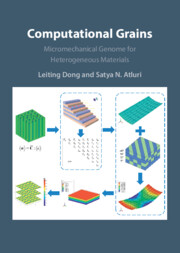Refine search
Actions for selected content:
11 results
5 - Computational Grains for Particulate Composites and Porous Materials
-
- Book:
- Computational Grains
- Published online:
- 05 October 2023
- Print publication:
- 19 October 2023, pp 72-109
-
- Chapter
- Export citation
12 - Multi-Scale Modeling of Composite Structures Using Computational Grains
-
- Book:
- Computational Grains
- Published online:
- 05 October 2023
- Print publication:
- 19 October 2023, pp 237-273
-
- Chapter
- Export citation
10 - Computational Grains for Piezoelectric Composites/Porous Materials
-
- Book:
- Computational Grains
- Published online:
- 05 October 2023
- Print publication:
- 19 October 2023, pp 192-205
-
- Chapter
- Export citation
8 - Computational Grains for Composites with Coated Inclusions
-
- Book:
- Computational Grains
- Published online:
- 05 October 2023
- Print publication:
- 19 October 2023, pp 144-167
-
- Chapter
- Export citation
7 - Computational Grains for Nanocomposites
-
- Book:
- Computational Grains
- Published online:
- 05 October 2023
- Print publication:
- 19 October 2023, pp 127-143
-
- Chapter
- Export citation
4 - Trefftz Trial Functions for Computational Grains for Planar and 3D Problems
-
- Book:
- Computational Grains
- Published online:
- 05 October 2023
- Print publication:
- 19 October 2023, pp 45-71
-
- Chapter
- Export citation
9 - Computational Grains for Viscoelastic Composites
-
- Book:
- Computational Grains
- Published online:
- 05 October 2023
- Print publication:
- 19 October 2023, pp 168-191
-
- Chapter
- Export citation
3 - Direct Numerical Simulation of Materials Using Computational Grains
-
- Book:
- Computational Grains
- Published online:
- 05 October 2023
- Print publication:
- 19 October 2023, pp 27-44
-
- Chapter
- Export citation
6 - Computational Grains for Cylindrical Fiber Composites
-
- Book:
- Computational Grains
- Published online:
- 05 October 2023
- Print publication:
- 19 October 2023, pp 110-126
-
- Chapter
- Export citation
11 - Computational Grains with Embedded Microcracks in the Matrix and Inclusions
-
- Book:
- Computational Grains
- Published online:
- 05 October 2023
- Print publication:
- 19 October 2023, pp 206-236
-
- Chapter
- Export citation

Computational Grains
- Micromechanical Genome for Heterogeneous Materials
-
- Published online:
- 05 October 2023
- Print publication:
- 19 October 2023
